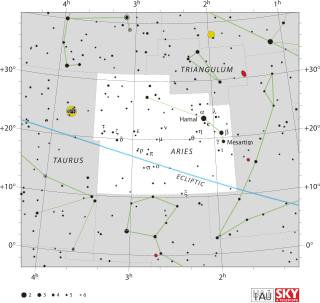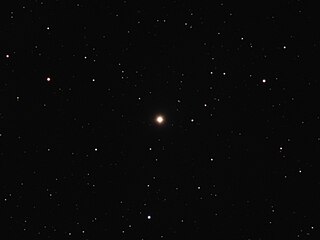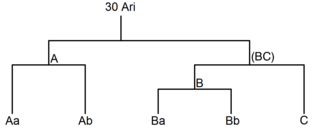
Aries is one of the constellations of the zodiac. It is located in the Northern celestial hemisphere between Pisces to the west and Taurus to the east. The name Aries is Latin for ram, and its symbol is , representing a ram's horns. It is one of the 48 constellations described by the 2nd century astronomer Ptolemy, and remains one of the 88 modern constellations. It is a mid-sized constellation, ranking 39th overall size, with an area of 441 square degrees.

Hamal, designation Alpha Arietis, is the brightest star in the northern zodiacal constellation of Aries.

Beta Arietis, officially named Sheratan, is a star system and the second-brightest star in the constellation of Aries, marking the ram's second horn.

Delta Arietis, officially named Botein, is a star in the northern constellation of Aries, 1.8 degrees north of the ecliptic. The apparent visual magnitude is 4.35, so it is visible to the naked eye. It has an annual parallax shift of 19.22 mas; corresponding to a distance of about 170 light-years from the Sun.

Gamma Arietis is a binary star in the northern constellation of Aries. The two components are designated γ¹ Arietis or Gamma Arietis B and γ² Arietis or Gamma Arietis A. The combined apparent visual magnitude of the two stars is 3.86, which is readily visible to the naked eye and makes this the fourth-brightest member of Aries. Based upon parallax measurements obtained during the Hipparcos mission, the distance to Gamma Arietis from the Sun is approximately 164 light-years.

41 Arietis is a triple star system in the northern constellation of Aries. With an apparent visual magnitude of 3.63, this system is readily visible to the naked eye. It has an annual parallax shift of 19.69 mas, which indicates it is at a distance of 166 light-years from the Sun.

Pi Arietis, Latinized from π Arietis, is the Bayer designation for a multiple star system in the northern constellation of Aries. Based upon parallax measurements made during the Hipparcos mission, this system is approximately 800 light-years distant from Earth and has an apparent visual magnitude of 5.21. This is bright enough to be faintly seen with the naked eye.

Tau2 Arietis, Latinized from τ2 Arietis, is the Bayer designation for a binary star in the northern constellation on Aries. The combined apparent visual magnitude of this system is +5.09, which is bright enough to be seen with the naked eye. With an annual parallax shift of 10.27 mas, it is located at a distance of approximately 320 light-years from Earth, give or take a 20 light-year margin of error. At this distance the brightness of the star is diminished by 0.18 in magnitude because of extinction from interstellar gas and dust.

39 Arietis, officially named Lilii Borea, is a star in the northern constellation of Aries. It is visible to the naked eye with an apparent visual magnitude of +4.5. The distance to this star, as determined from an annual parallax shift of 19.01 mas, is approximately 172 light-years.
52 Arietis is a triple star system in the northern constellation of Aries. 52 Arietis is the Flamsteed designation. The combined apparent magnitude is +5.46, which is bright enough to be faintly visible to the naked eye. Based upon an annual parallax shift of 6.05 mas, the system is roughly 540 light-years distant from the Earth. The inner pair of this system consist of two nearly identical B-type main sequence stars, each with about five times the mass of the Sun. The tertiary component is a smaller star with 88% of the Sun's mass, and is a common proper motion companion.
15 Arietis is a single variable star in the northern constellation of Aries. 15 Arietis is the Flamsteed designation; it also bears the variable star designation AV Arietis. It has an apparent visual magnitude of 5.74, which is just bright enough to be visible to the naked eye from dark suburban skies. An annual parallax shift of 5.84 mas corresponds to a physical distance of approximately 560 light-years from Earth. At that distance, the star's brightness is reduced by 0.33 in magnitude because of extinction from interstellar gas and dust.
62 Arietis is a single star in the northern constellation of Aries, a few degrees to the north of Tau Arietis. 62 Arietis is the Flamsteed designation. It is visible to the naked eye as a dim, yellow-hued star with an apparent visual magnitude of 5.52. Based upon an annual parallax shift of 4.7±0.1 mas, it is approximately 690 light-years distant from the Earth.
20 Arietis is a single star in the northern constellation of Aries. 20 Arietis is the Flamsteed designation. It has an apparent visual magnitude of 5.79, which is bright enough to be just faintly visible to the naked eye as a yellow-white hued star. The star is located approximately 137 light years away from the Sun based upon parallax. It has a relatively high proper motion, traversing the celestial sphere at the rate of 0.188 arc seconds per annum. 20 Arietis is receding from the Earth with a heliocentric radial velocity of +25 km/s.
56 Arietis is a single, variable star in the northern zodiac constellation of Aries. It has the variable star designation SX Arietis, while 56 Arietis is the Flamsteed designation. This object is visible to the naked eye as a faint, blue-white hued point of light with a baseline apparent visual magnitude of 5.79. The estimated distance to this star is approximately 406 light-years, based on parallax, and it is drifting further away with a radial velocity of +18 km/s.
53 Arietis is a variable star in the northern constellation of Aries. 53 Arietis is the Flamsteed designation; it also bears the variable star designation UW Arietis. It is a B-type main sequence star with a stellar classification of B1.5 V and mean apparent magnitude of 6.10, which is near the lower limit for naked eye visibility. Based upon an annual parallax shift of 3.92 mas, the estimated distance to this star is roughly 800 light-years.

30 Arietis is a 6th-apparent-magnitude quadruple star in the constellation of Aries. 30 Arietis is the Flamsteed designation. 30 Arietis A and B are separated by 38.1" or about 1500 AU at a distance of 130 light years away. The main components of both systems are F-type main-sequence stars, meaning they are fusing hydrogen in their cores. 30 Arietis A is itself a spectroscopic binary with an orbital period of 1.1 days. The 30 Arietis system is 910 million years old, one fifth the age of the Sun.
51 Arietis is a star in the northern constellation of Aries. 51 Arietis is the Flamsteed designation. It is a dim, yellow-hued star – a challenge to view with the naked eye, having an apparent visual magnitude of 6.6. Based upon parallax measurements, the star is located at an estimated distance of 67.3 light-years from the Sun. It is receding from the Earth with a heliocentric radial velocity of +9.5 km/s, and is a member of the IC 2391 moving group.
57 Cancri is a double star in the zodiac constellation of Cancer, located around 460 light years away from the Sun. They are visible to the naked eye as a faint star with a combined apparent visual magnitude of +5.40. The brighter member, designated component A. is a yellow-hued giant star with a stellar classification of G7 III and an apparent magnitude of +6.09. Its companion, component B, is an orange-hued giant with a class of K0 III and an apparent magnitude of +6.37. As of 2017, the pair had an angular separation of 1.50″ along a position angle of 310°.

Silvano Arieti was a psychiatrist regarded as one of the world's foremost authorities on schizophrenia. He received his M.D. from the University of Pisa and left Italy soon after, due to the increasingly anti-Semitic racial policies of Benito Mussolini.
HD 41162 is a star in a double system.




